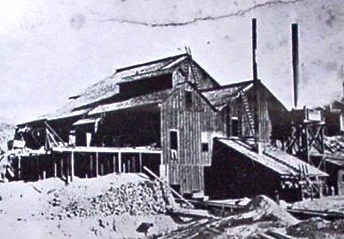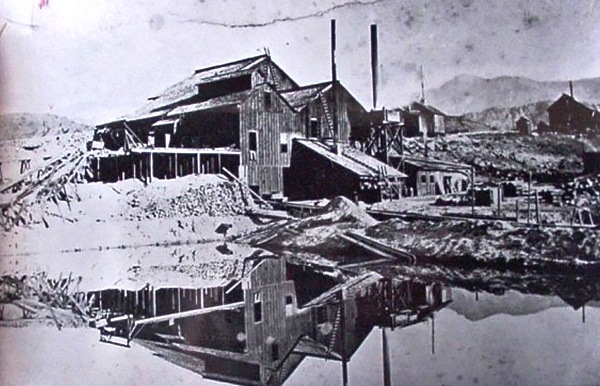
WASHINGTON COUNTY HISTORICAL SOCIETY (Washington County, Utah)
CHRISTY MILL
Silver Reef, Utah
LOCATION
Located in the Silver Reef town site.HISTORY
The Christy Mill was one of Silver Reef's most productive mills, operating from 1878 to the 1890s. The company that operated the mill for much of its life, the Christy Milling & Mining Company, was incorporated in 1877 and immediately began drawing up plans for the construction of a mill. The company's superintendent, Henry S. Lubbock, former Captain of the 3rd Regiment California Volunteer Army, spent several months raising money for the mill.Construction on the Christy Mill began in October 1877, and was completed on January 8, 1878. The mill was a stamp mill with five stamps that weighed 850 pounds each, a 40 horsepower engine, and many other commodities that were common among mills of the day. The mill was able to process 85% of the silver that came through it; the rest was dumped into slime pits and reworked for the rest of its value. The average fineness of the silver that came from the Christy Mill was .930. Twenty men were employed in the mill in 1878, and the mining company paid its mill hands $2,600 cumulatively every month, or about $130 per month per person.
Prosperity continued throughout 1878 and 1879, but the mill was almost burned down on May 21, 1879. A cord of wood caught fire in the late afternoon, and the sound of the Christy Mill's whistle alarmed Silver Reef's residents of the fire. A group of townspeople quickly organized themselves and poured water on the fire and the nearby mill, hoping the mill didn't catch fire. The efforts of these people saved the mill, and a wind from the southwest saved the town of Silver Reef from catching on fire. Although the mill itself wasn't burned, about 215 cords of wood, valued at $1,500, were destroyed completely. It was determined that sparks from the mill's smokestack had started the blaze.
A couple other fires started the next day, but these weren't as major as the fire of the previous day and were quickly handled. By late 1879, the mill was looking as good as ever, crushing about 40 tons of ore per day. During this time, Captain Lubbock considered increasing the capacity of the mill by adding five more stamps, but this was never done. Still, the Christy Mill processed an impressive $218,717.10 in 1879.
In 1880, some ore taken from the Tecumseh Mine was observed to have flecks of yellow in it, but nothing was thought of it and the ore was sent to the Christy Mill for processing. The ore was put through the mill, and when it was poured into the mold and appeared to be solid, it would begin to swell up until it was four inches above the rim of the mold. To compensate, the molder kept the silver in the pot for longer than usual before pouring it into the mold, and this often stopped this occurrence from happening.
When samples of this "yellowish" substance were taken by a man affiliated with Hamilton College in New York, testing was done on them. The man concluded that the ore had small traces of uranium; but since there was no use for uranium at that time, nothing was ever done with it. In the 1950s, though, the United States Geological Survey came across old mill records and discovered that there was uranium in Silver Reef, and 2,500 pounds of uranium was mined from various mines in the area. And all because of an accidental discovery in the Tecumseh Mine and the Christy Mill.
In January 1881, most of the mills in Silver Reef were renovated with more modern milling machinery. A major setback for two of Silver Reef's major mining companies occurred in February and March of 1881, when the Stormont Mining Company and Barbee & Walker Mining Company decided to lower their daily wage rate from $4 a day to $3.50 a day, causing many of their employees to quit and join the Miners Union in Silver Reef. The Christy Mining Company kept the $4 daily wages throughout the labor strike, but lowered their wage rate to $3.50 when the Miners Union finally decided to accept the lowered rate in April of 1881.
Throughout most of the 1880s, the Christy Mill remained prosperous. From January 1 to September 30, 1881, the mill processed $233,027.60 worth of silver bullion, and the company employed 80 men, dozens of whom worked in the mill. In 1882, only two mines were providing the Christy Mill with ore, but even at this time the mill was processing 40 tons of ore daily. From 1883 to 1885, the capacity of the mill averaged 50 tons of ore daily; but from 1885 onward, production from the mill began to decline.
Regardless, the mill was improved yet again in September of 1887 when an electric system was installed. The system gave the mill an extra 50 cents in profits per ton of ore processed, and proved to be very efficient. But in 1889, the Christy Mining Company filed for bankruptcy, and the mill was shut down for about a year. Woolley, Lund & Judd, a mercantile company operating in Silver Reef, leased the Christy Mill in 1890 and made a forty-nine day run of 35,801.22 ounces of silver.
A man named D. M. Tyrell apparently bought out the bankrupt Christy Mining Company in 1892 and ran the mill a couple times, but very few records exist of his tenure at Silver Reef. The mill was apparently closed down for good by the end of 1893.
Historians debate what happened to the Christy Mill after its final closure. Some say that it was moved to Park City and used there. Although Park City was a very prosperous mining city at that time, there's nothing in The Park Record, Park City's newspaper, that suggests that a mill was moved from Silver Reef to Park City at any time. Other records indicate that the mill was simply scrapped; its machinery was sold to select buyers and its lumber was used to build homes and businesses in the area. Although this was the fate of many buildings in Silver Reef, a photo dated from the 1950s shows that the Christy Mill was, indeed, still standing at that time.
In the 1950s, the United States Geological Survey examined the tailings of the Christy Mill, considering working them for their silver and uranium content, and although they did mine quite a bit of uranium from the area, very little work was done on the tailings. Very few tailings from the mill exist today, and the mill itself was torn down at some point between the 1950s and the 1980s. Regardless of when it was torn down, all that remains today is the mill's foundation, but the history of the mill is preserved in old mining records.
PHOTOS

WCHS-03125 Christy Mill with its reflection in the mill pond in the foreground
Other WCHS photos:
WCHS-01169 Photo of the Christy Mill in Silver Reef (similar to WCHS-03125 but higher resolution)
REFERENCES
Proctor, Paul Dean; Shirts, Morris A.Silver, Sinners and Saints: A History of Old Silver Reef, Utah
Paulmar Publishers, Inc., 1991
Carr, Stephen L.
The Historical Guide to Utah Ghost Towns
Western Epics, 1986
Beal, Alex.
Oral history of Silver Reef
(personal interview by Jon Alvey)
The Salt Lake Tribune
(articles published from 1877 to 1891)
The Cedar Record
(article published on December 22, 1893)
Stugard, Frederick Jr.
Physical Exploration for Uranium During 1951 In the Silver Reef District Washington County, Utah
United States Geological Survey, 1953
King, Clarence; Emmons, Samuel Franklin; Becker, George Ferdinand
Statistics and technology of the precious metals
Washington: Government Printing Office, 1885